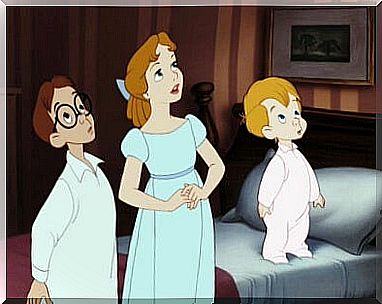Peter Pan, The Story Of The Boy Who Did Not Want To Grow Up

Peter Pan is a well-known British play by writer James M. Barrie. The play is intended for children and premiered in London in 1904. Before becoming a play, the character Peter Pan appeared in a Barrie novel. In this first version, Peter lived in London and all the children were half bird, which is why they could fly.
Barrie was improving his novel and adding new features that we will see in the play. Among the novelties, the introduction of fairy dust to be able to fly stands out, something that had to be included given the accidents that were taking place in the city by children who believed they could fly.
Peter Pan: where did so much inspiration come from?
Barrie was inspired by Kensington Gardens in Hyde Park, a place where he used to spend a lot of time and where he frequented the Llewelyn Davies family, whose children would inspire the story and used to play in the gardens.
If we go to London and visit Hyde Park, we will find the statue of Peter Pan in the gardens. This statue is not there by chance, but was placed by the author of the work himself in 1912. He did it as a gift to the children of London and placed it in the place where Peter landed in the first version of the work. In addition, Barrie decided to assign the rights to the work to Great Ormond Street Children’s Hospital in London.
Without a doubt, the legacy of Peter Pan seems infinite and has led to countless adaptations in both theater and film. Today we will focus on what is perhaps the most iconic, the 1953 Disney adaptation.
Neverland
Never Land is a remote island that is reached by flying to the top of the sky, then you must “turn on the second star to the right, flying until dawn.” It is a place where there are no laws and the children who inhabit it have no responsibility, they spend most of their time playing and having fun.
This island may remind us, in part, of Pinocchio’s Island of the Games, a film in which Peter Pan is referred to . In both, the children who inhabit the island do not want responsibilities or grow up, they are remote places that adults cannot access and where they can do whatever they want. However, unlike Pinocchio, the children who inhabit Neverland are the so-called Lost Boys, those that no one has claimed.

Fantastic creatures such as mermaids and fairies inhabit the island, but also Indians and pirates. The more time they spend on Neverland, the more difficult it will be to get out, reclaim their life and their memories.
We can see Never Never as an idyllic place where everything is possible, a place full of adventure and fun. However, it is also a trap, because there the children cannot grow, never reach maturity and, as a consequence, have short-term memory.
Wendy, reason and maturity
Wendy lives with her family in London until one night Peter Pan shows up at their house and takes them to Neverland.
At the beginning, Wendy is a girl like the others and she is happy about it, just like her brothers, she is excited at the idea of being able to fly and visit Neverland, so she agrees and begins her journey with Peter.
Peter and the Lost Boys will see in Wendy a mother figure, a person who can take care of them and tell them stories. In Neverland there are no girls and they lack any kind of protection or maternal figure, so that will be Wendy’s job.

Little by little, you will realize the importance of growing for your own personal development and will come to acceptance. She will become a kind of mother to the Lost Children and eventually convince herself that she must move towards that growth.
Wendy is the female character that we find in contrast to Peter. She is a responsible girl, who takes care of her younger siblings and aspires to become a grown woman. In addition, it is the rational part that complements Peter.
Peter Pan, the boy who didn’t want to grow up
Peter Pan is the protagonist, he is a boy who lives in Neverland and does not remember anything about his past. He acts as the leader of the Lost Boys because, even in that world without rules, the figure of the leader is necessary, which, in this case, falls on Peter.
Peter is also the one chosen to save Never Land. He is always accompanied by the Lost Boys and by Tinker Bell, a very jealous and possessive little fairy.
In reality, Peter is a child who is afraid to grow up, face problems and reach maturity. He seems very brave when he laughs at Captain Hook, mocking him and driving him out of his mind, but he is not brave enough to face real world life and maturity.
Peter Pan and the power of imagination
It has an overflowing imagination, thanks to which it can fly. He is cheerful and does not see danger, his leadership skills are truly amazing. Furthermore, it is he who convinces Wendy and her brothers to visit Neverland.
We see this leadership and power of conviction when he shows children that their thoughts will make them fly, they only have to believe in themselves, they have to believe that it is possible and emit happy thoughts, in this way and with the help of powders. fairy, they can fly like Peter.
Flight is something closely associated with imagination and freedom. Humanity seems to have always longed for the flight of birds, perhaps because it is considered something unattainable and almost divine. When we are children, it seems that one of our greatest desires is precisely the ability to fly. For this reason, we see that Peter, a child in a pure state and without alterations from the adult world, gives free rein to his imagination and can fly.
Children’s imaginations are really powerful and fascinating. However, because of the rationality of adults, it is limited. This is why the Lost Boys and Peter Pan have a totally outsized imagination. Well, it hasn’t been altered by any adult in a long time.
The importance of being who we are
Peter Pan has a very charismatic personality, but he also shows himself to be a very carefree and clueless child, losing his own shadow. This loss of shadow also shows a loss of identity. A problem accepting yourself. A kind of alienation from one’s own personality.
The shadow is like a mirror, where we recognize ourselves, it is something that is linked to us, that belongs to us. But Peter constantly loses her, that is, he loses himself. Peter hides from his shadow, he does not control it, because he runs away from what he fears most: growing up.
This work has given rise to multiple interpretations and countless adaptations. In addition, it has served to categorize the well-known Peter Pan syndrome. That is, people who do not want to grow or reach maturity. Also, to Wendy’s syndrome, people obsessed with satisfying others and that underlies the fear of rejection. Peter Pan is undoubtedly one of the UK’s most iconic works.









